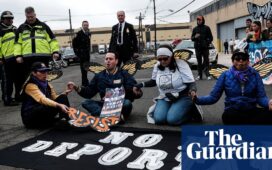For as long as I have been a mother, I’ve had recurrent nightmares about water carrying my children away. In the dreams, my sons slip quietly beneath the surface, becoming blurry underwater shapes, and then disappearing completely. My panic is animal – a pulsing in my ears, static in my brain, a scream-howl building in my chest. I wake up thrashing against the water, searching desperately for my boys.
When the news broke of 23-month-old Valeria and her father, Óscar Alberto Martínez Ramírez, Salvadoran migrants who had been swept away by the Rio Grande, I was camping along a river in northern Arizona, without access to the internet. I had been photographing plants and making videos of the river to show my desert children, who were at home in Tucson with my parents. When I emerged from the woods, I came face-to-face with a gas station newspaper and saw it.
Is it possible to see an image only in pieces? For a photograph to resemble the very splintering of a heart? Because standing in the gas station – my toes still coated in river muck and 200 miles from my children – I saw only fragments: a toddler’s tiny arm looped around her father’s protective neck; her waterlogged diaper, bulging beneath a pair of red pants; the tiniest blue shoes. Father and daughter, lying face down in the mud among a stand of bamboo. And what had collected around them in the brackish water, but a discarded water bottle and several blue cans of beer, crudely glaring in the June sunlight.

Valeria’s mother, Tania Vanessa Ávalos, will not wake up from this nightmare. She will not wander, grateful and sleepy down the hallway to inhale the smell of her daughter’s hair.
Nor will the parents of six-year-old Gurupreet Kaur, an Indian migrant who died of heatstroke in the Arizona desert, two hours from my house. Or the parents of Aylan Kurdi, the three year-old Syrian boy found washed up on the Turkish coast in 2015.
How many times must a child wash up on a shoreline or collapse in the desert before the very force of our collective grief and rage throws the Earth right off its axis – or at the very least, shatters the policies that support such suffering and death?
Valeria’s grandmother told the Washington Post: “They wanted a better future for their girl.” Gurupreet’s parents said in a statement: “We wanted a safer and better life for our daughter and we made the extremely difficult decision to seek asylum here in the US. We trust that every parent, regardless of origin, color or creed, will understand that no mother or father ever puts their child in harm’s way unless they are desperate.”
And yet, we have weaponized our wild spaces in a blatant attack against those most desperate.
My home in the Arizona borderlands has become a corridor of bones since the 1994 implementation of a US border strategy called “Prevention tThrough Deterrence”, which saw urban centers from Brownsville, Texas, to San Diego, California, outfitted with increased military infrastructure in the form of surveillance technology, walls, and border agents.
The US government’s goal was to funnel migrant traffic into remote and dangerous landscapes, thereby deterring migrants from making the journey. But the strategy does nothing to address the root causes of migration, and the result is not fewer border crossers – it is a gauntlet of death. More than 7,000 migrants have been found dead along the US-Mexico border over the last two decades, though this number is estimated to be only a fraction of the true death count.
These deaths reverberate throughout our border communities. Several months ago, a friend came across the body of a woman in a remote part of the desert. She remains unidentified, just a GPS coordinate on a map. Years ago, my friend Dan Millis discovered the body of 14-year-old Josseline Hernandez, who was on her way from El Salvador to reunite with her mother in California. (Two days later, Dan was ticketed for littering by US Fish and Wildlife officers, after leaving water jugs in the same area for migrants in distress. His conviction was overturned by the ninth circuit court of appeals.)
And just weeks ago, several sets of human remains were found – just as federal prosecutors were arguing their case against Scott Warren, the geography professor who was facing 20 years in prison for providing food, water and directions to two migrants (the trial resulted in a hung jury).
If you have never been to the Arizona desert, I will tell you that it is stunningly beautiful. This time of year, the saguaro flowers are bursting open, spilling blood red fruit for the birds and bats. Forests of cholla cactus glow in the golden hour just before sunset and the mountains turn magenta. And the antiseptic smell of creosote is as intoxicating as any perfume.
But the desert is also a disorienting expanse of cactus and scrub. One arroyo often looks identical to another, and it is easy to become lost. Temperatures can rise to 120F in some places, and shade is scarce, if not nonexistent. In the middle of a summer afternoon, the ground can feel like a branding iron. During monsoon season, the driest arroyo can become a rushing river in a matter of seconds, sweeping away anything in its path.
How is one to reconcile the beauty of this earth, with the weapon that humans have made of it? We have turned the power of our rivers, the expansiveness of our oceans, the wildness of our deserts against parents who are carrying their babies across entire continents, because any choice they had has long run out.
With each breaking news alert, I measure the space between me and my sons. It is instinct: if danger presented, how quickly could I reach them? With each report – children kept in cages, without diapers and sufficient food, children taking care of younger children torn from the breasts of their mothers – my horror gives way to rage. But rage is animal. It collects like water droplets until it becomes a river, until it breaks the dam.








